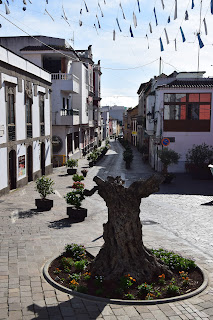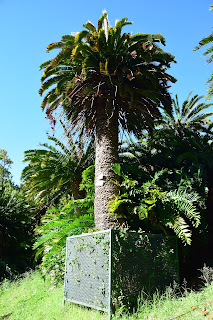We booked a personal tour for
Grand Canaria with a focus on the inland mountains and away from the madding
crowds. We were met by Ines and Juanjo who were a fun couple of which more in a moment. Our first stop
was San Mateo with its picturesque square and church. The dead tree trunk in
the foreground has been given a new life.
Inside the church was simple and
neat with the exception of the roof which is a carpenter’s work of art.
The church overlooks the original
main street with housing which (for the 17C) would have been very posh and in
stark comparison to the other side of the church square.
Poor people could only afford dry
stone walls. As time passed they would have been gradually able to access lime and slowly
infill the stones to keep out the drafts. They were unlikely to be able to
afford a completely lime (or later cement) rendered wall. Of course now the
buildings are heritage listed and they are not allowed to render them in any case!
After some coffee in a noisy
local establishment we continued to climb and towards the top had a stop with a
commanding view. Most of the mountains are quite rugged. The island has coastal
people and inland people with some of the latter eking out a living as farmers
and rarely travelling to the coast. Some lived in caves and if you look closely
towards the bottom of the main hill you can see a few of these.
The view attracts a few visitors
and there were a few stalls with wonderful local produce. Most of the
interior is too steep and dry for cows so the cheese is made predominantly from goat’s milk with
some combined with sheep’s milk. It was hard to resist the tastings.
Turning your back didn’t work!
The tastings did whet our appetite
for lunch. We were taken to a pine forest where our guides put on
some splendid local tapas like fare. (Not to mention Rjoca.)
After
lunch our extrovert guides had us praying to the sun gods resulting in music
emanating remotely from within the back pack. Lo and behold a bottle of locally
produced dessert rum trying to get out….
The
stop really produced a feeling of dejavu as it was so similar to camp sites in
Canada. The smell of pine and birdsong added to very relaxed surroundings.
Suitably
refreshed we continued ever upwards with our next stop the highest point on the
island. In their younger days our guides used to host sky diving activities. Clearly
some still have a yearning to fly.
The
height here is some 2000 metres above sea level. Which is almost three times
higher than Canberra. That said it pales into insignificance compared to Tenerife which can be seen in the background above the clouds. The high point there is some 4000
metres.
Looking
West the land has given way to some development although the terrrain has
ensured it is sparse. The visible point on the left of this shot is, at 1965 metres, the highest on the island. What was amazing were the number of cyclists who had
made their way up. Comments like ‘you are never too old’ were not particularly
convincing from my perspective….
And with that there was only one
way to travel. On the way down we stopped at the Caldera de los Marteles. Interestingly,
the bottom of this Caldera is fertile and a perfect grassland area. We were
particularly lucky with our Spring timing as colourful blooms were everywhere.
Our route down included a long, narrow and largely one lane
road. Fortunately stopping for a picture was not a problem as other traffic was
almost non-existent. Here is a cave house. The sun shade over the entrance was
a little extravagant….
And then the catholic church
arrived. Initially in 1560 a small hermitage was built but over the years this
was discarded and rebuilt to its current format. Although inaugurated in 1908 it
was not completed until the 1940s! Certainly, somewhat of a ‘show off’ compared
to the quality of house most lived in.
And with that we returned to QM2. A fantastic day which really opened our eyes to what the Canarie islands have to offer. The antics of our guides with a range of music, iPad shows in the car and their third team member (the car plus a lot of imagination) really differentiated this tour from any other we have been on. A thoroughly enjoyable day.




















































